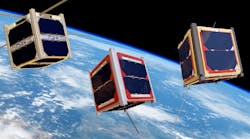Both military and commercial users are expressing growing interest in the use of smaller satellites, such as CubeSats, for communications and surveillance. To make such small satellites practical in terms of production and testing, however, design and assembly methods are being carefully considered to achieve higher reliability through the use of newer technologies.
As an example, electronic systems that are on board a satellite but may not initially be needed, are typically activated sometime following a launch by the use of a “meltwire.” This is an electrically heated wire or resistor in which a restraining element is melted by the applied electricity, allowing the activation of the required circuit. Unfortunately, such actuators can only be used once and cannot be effectively tested prior to the flight of the satellite.
Researchers at The Aerospace Corp., including Jerry Fuller of the organization’s Small Satellite Development and Operations, have been searching for reliable alternatives to meltwires as actuating mechanisms for small satellites, leading to the discovery of shape-memory alloys such as nickel-titanium (nitinol) alloys. Such alloys can change shape—and even shrink—in response to changes in temperature. And they can be used and reset many times, allowing for the testing of an actuation process on board a small satellite.
Shape-memory alloys such as nitinol can be designed in almost two-dimensional configurations, a tremendous benefit for applications such as smaller satellites where mass and volume must be minimized. Fuller is exploring possible replacements for meltwires based on mechanical functions implemented with lengths of nitinol wire. Since the wire contracts when heated, it is used to remove a restraint as it shrinks.
To create a mechanical function, a length of wire must be “trained” during fabrication to be a certain length. “If you stretch it a little bit, then heat it up [usually to about +90ºC], it will contract to its original, trained length,” Fuller explains. To achieve useful mechanical functions, small lengths of wire are involved, with wires that may be only a few thousandths of an inch in diameter, but nonetheless can exert sufficient force during contraction to serve as actuators.
Actuators based on shape memory allows have already flown on several CubeSats built by The Aerospace Corp, and are scheduled to fly on upcoming missions. The actuators are light and simple and can fit in the tight spaces allowed by these small satellites. They can be designed without lubrication and do not suffer from residual magnetism. “We’ve used shape-memory wire actuators to release solar arrays, deorbit-drag devices, antennas,” Fuller notes. “Virtually any one-time-use actuator can be designed as a shape-memory wire actuator.”


